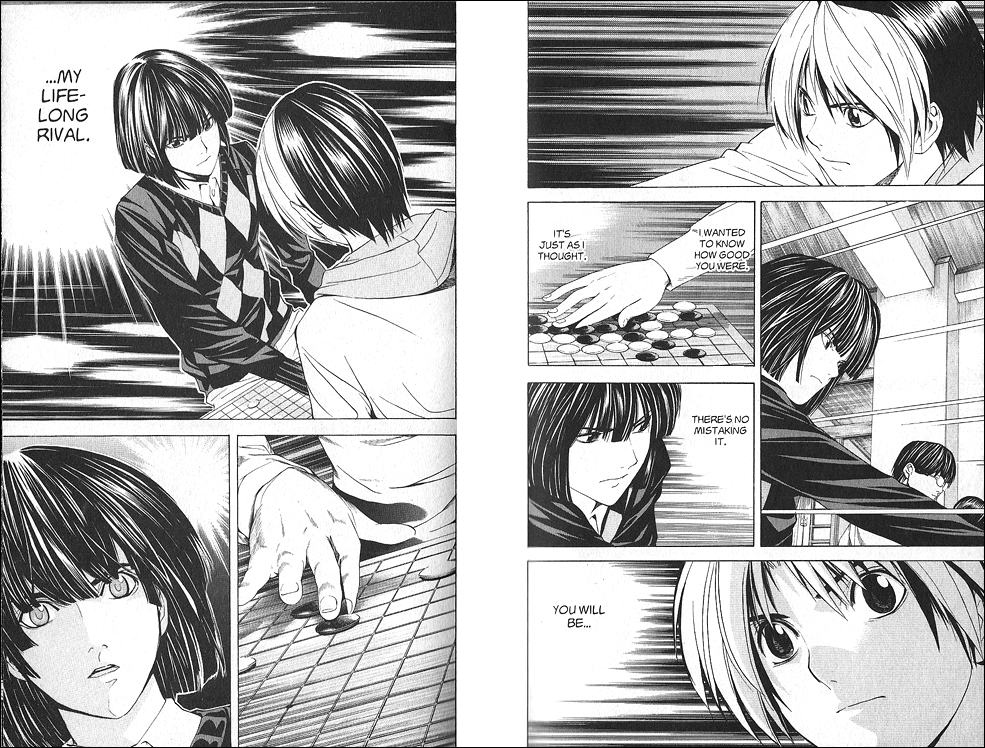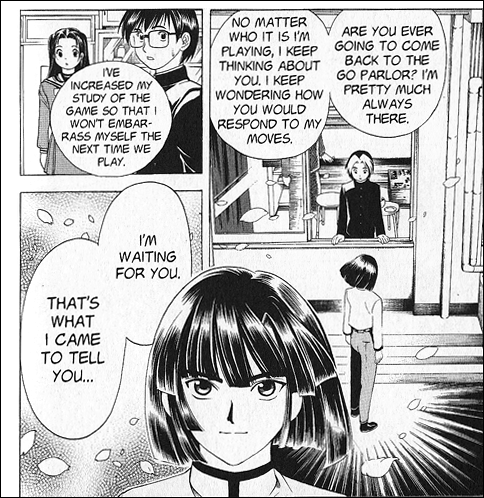Though I rarely wax nostalgic over flame wars, I’ll admit that searching for the comment I quoted in yesterday’s “Soapbox” post led me to revisit the material that inspired it. I won’t reiterate the entire argument here, or even my entire premise, but here’s a brief excerpt that I think expresses quite well what my purpose is in experiencing and writing about fiction:
“My focus as a reader/critic/human being is now and always will be discussion/analysis of a work’s emotional content. That is what I know about, and that is what I’m most interested in and qualified to write about. That is what my background prepares me for. That is what I care about in the world. The real purpose of fiction in my life is that it gives me the opportunity to interact directly with someone else’s inner life. This is not only what I find most compelling about other people, but I’d even go so far as to say it’s the way I best connect with the human race as a whole. It’s is a delicious smorgasbord of humanity. It’s where people communicate what’s most important to them, often even within formulaic structures and “fluff” pieces. It is, on a very basic level, a window into another person’s soul.”
Let me elaborate just a little on that. Like a lot of voracious readers, I’m a fairly introverted person. One of the side-effects of this is that I spent the vast majority of my growing years appreciating and cultivating my own inner life to a much greater extent than the one I physically shared with other people. This does not mean that I don’t like other people or don’t enjoy interacting with them. It does mean that I often find I understand other people more easily when I’m given the opportunity to examine their inner lives, and since I think understanding other people is a pretty vital part of life, I spend a lot of time doing that.
It is this, along with a number of other factors, that led to me spending most of my youth and a large chunk of my working adulthood as a singer and stage actress. As immersive as reading or watching fiction can be, there is nothing more revealing (and, frankly, thrilling) than exploring someone else’s inner world by actually becoming a player in it. It’s a transformative experience in every way, and I recommend it heartily, if not as a way of life, at least as an enlightening pastime.
I bring all this up, because I’ve previously mentioned that I think my approach as a manga critic is deeply informed by having been an actor, but I’ve never really explained what that means. What I mean when I say that, is that I think being an actor gave me some specific tools for understanding storytelling, particularly in terms of characterization and emotional truth (the two main elements I’m referring to when I mention “emotional content”), both of which are essential to effective, believable fiction, regardless of medium.
Now, to the point! All this has been a fairly long-winded introduction to this week’s 3 Things…
3 critical elements of characterization in storytelling I learned from The Theater:
1. Intention. I’m not here to argue acting technique, and frankly, I think a lot of it is pretty hit-or-miss, but I will say that out of all the various techniques I encountered during my years of study and professional work, the thing that consistently worked for me was a focus on intention. What do I want, and how do I get it? Nearly everything we do as human beings is motivated by intention, and this is true of fictional characters as well, at least the ones that are written effectively. One of the things I most enjoy looking at when I’m analyzing comics, is the intention of each of the story’s characters, and how consistently the author is able to maintain those intentions throughout the work. Certainly a particular character’s intention may change over the course of a series (and even within that, there is an intention in every moment that may actually, realistically conflict), but a strong writer will discover that her characters’ intentions are more important than her own when it comes to writing a believable story. Which brings us nicely to…
2. Truth. When asked if he preferred playing good guys or bad guys, Willem Dafoe is famously quoted as having said, “Ain’t no difference. Everybody thinks they’re righteous.” This is absolutely so, and a failure to recognize this fact is why so many stories that feature the concept of “good vs. evil” fail to ring true. People are masters of self-deception, and all of us will do what we convince ourselves is right, even if “right” translates as “right for us” or “the right way to avoid having to do things we don’t like.” Even if we say we did something we know is wrong, we’ve still justified to ourselves why we were “right” to do it anyway. That’s just what we do. It’s how we continue to go on. While humans as a society may strive (mostly unsuccessfully) to identify common truths, it’s clear to anyone who has spent five minutes watching the evening news that trying to lay out universal concepts of “good” and “evil” is beyond futile.
What’s not at all futile, however, is determining individual truth, and when it comes to characterization, this is vital. The best writers know how to separate their own personal truths (which may influence things like theme) from the individual truths of their characters, allowing each of them to exist truthfully and independently in the story. When something reads as out of character, most of the time it’s because the writer has forgotten this, or has tried to use a character as a shortcut to the writer’s own truth. This really never works. For an actor, this kind of writing is deadly, because it means she must take actions that are at odds with her intentions. This is no less deadly for a comic.
3. Show, don’t tell. But don’t “show” either. “Show, don’t tell,” is a pretty fantastic mandate. It instructs writers of all kinds to let both their own ideas and their characters’ intentions be revealed through action instead of narration or inner dialogue, and often an adherence to this directive is what makes the difference between a story that doesn’t work and one that does. But one thing actors learn pretty early on, is that sometimes “showing” can be just the same as “telling.” What I’m talking about here is what we’d refer to in high school acting class as “indicating.” When an actor is “indicating,” instead of doing something, she’s trying to show the audience that she’s doing something, essentially telling them what she feels by using familiar gestures or visual cues. For instance, instead of thinking, “I’m really sad,” and acting on her whatever her intention is from that point, she’s thinking, “I have to show the audience that I’m really sad,” and actually trying to make that her intention. You might think this works, but it doesn’t, because instead of watching the character, the audience is actually watching the actor, which is not the same thing at all, and will never read as true.
Comics creators can fall into the same trap, essentially using “showing” as “telling,” even without narration or dialogue. A writer may think he is carefully revealing his character’s thoughts and intentions in the manner of “show, not tell,” but because he’s so worried that the audience may not get it, he’s inserted some extra visual cues and emphasis, just to make sure, and before he knows it, he’s actually telling instead, even without using any words. This pulls us out of the character’s truth and into the author’s process, making the character less believable.
With a character’s truth and intention in place, any comic can be believable, whether it’s a deep look at the psychology of mountain climbers or a cracktastic boys’ love epic. Any type of story can be believable if it is rooted in emotional truth, and it is through these stories that we continue to understand and learn from each other as we struggle with the realities of our lives. Creating, distributing, and experiencing/interacting with art is the most powerful method we have for establishing human connection.
And that’s what I learned from the theater.

 One of my favorite quotes so far from this month’s Manga Moveable Feast comes from David Welsh, as he describes why Wild Adapter is, in his words, “
One of my favorite quotes so far from this month’s Manga Moveable Feast comes from David Welsh, as he describes why Wild Adapter is, in his words, “ It’s been a while since I put together a Follow Friday post, and with all the recent additions to the Manga Bookshelf family, it seems only right to make sure you all know how and where to follow this fine group of writers. You can check out our
It’s been a while since I put together a Follow Friday post, and with all the recent additions to the Manga Bookshelf family, it seems only right to make sure you all know how and where to follow this fine group of writers. You can check out our  I received a PR piece recently from digital manhwa publisher iSeeToon, announcing three trailers for their upcoming iOS release, Ill-Fated Relationship, a dark romance featuring two serial killers. Two of these are available already, one from the
I received a PR piece recently from digital manhwa publisher iSeeToon, announcing three trailers for their upcoming iOS release, Ill-Fated Relationship, a dark romance featuring two serial killers. Two of these are available already, one from the 


















 After taking March off, Michelle and I are back with a new installment of
After taking March off, Michelle and I are back with a new installment of  Calling “classic” shoujo fans (yes, I have difficulty with the concept of stuff from the 80s being “classic”): This week, we’ve taken Off the Shelf on the road to
Calling “classic” shoujo fans (yes, I have difficulty with the concept of stuff from the 80s being “classic”): This week, we’ve taken Off the Shelf on the road to 

